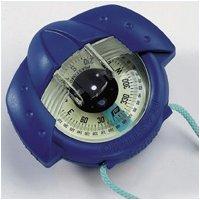The Compass
The Hand Bearing Compass
 |
A hand bearing compass is a small, portable
compass that is not meant to replace a boat's primarily steering compass.
It is used to take a bearing easier than with the steering compass.
Bearings are taken by holding the compass
in the hand close to the eye and by looking over the compass card to the
bearing object. The construction of the hand bearing compass should allow
simultaneous viewing of the bearing object and the compass card reading.
Despite the simple construction, the measurement results, when used from
a deviation-free location are remarkably good.
|
Hand bearing compasses usually have photoluminescent
compass cards. Exposing the compass card to the cabin light or a torchlight
ensures enough luminescence for taking night bearings. During daytime usage,
exposure to intense sunlight should be avoided.
|
Bearing of prominent charted objects can be plotted in a
nautical chart to obtain a Line-of-Position.
The intersection of two or more such lines yields a position fix.
The Line-of-Position is a straight line in the chart starting from the sighted object
- because this is normally the only known point of the bearing line -
drawn in the OPPOSITE direction of the bearing measured in the location of
the observer.
Notice, that two kind of bearings are involved:
- the bearing from the sighted object to the observer and
- the bearing from the observer to the sighted object
These bearings differ by 180°.
The bearings read from the hand bearing compass normally are the bearings
from the observer to the sighted object.
When using an unknown bearing compass, it should be checked
what kind of bearing the reading of the compass shows.
The process of drawing bearing lines into the chart to obtain a
Line-of-Position and finding a position fix is called plotting.
It is explained in detail in the section
Working with Nautical Charts.
Finding a deviation-free location to use a hand bearing compass
Since hand bearing compasses are not used on a fixed position,
no deviation table can be used to correct deviation errors.
As a consequence, bearings should preferably taken from deviation-free
locations on the boat well away from electronic and metallic gear.
The rear of the boat is usually a convenient location.
When the sea is calm, the deviation can be checked with
the following procedure:
Choose a sea or landmark to serve as point of reference. This point,
which doesn't have to be exactly identified, should be at least 3 nautical miles
away from the current location. While pinpointing the reference mark with the hand bearing compass,
turn the boat slowly around in a narrow circle of less than 0.05 nautical miles
(about 100 meter). If the bearings read from the compass remain constant, the location
on the boat chosen for taking the bearings is free from magnetic deviation.
|
 |
When a deviation-free location has been found on the boat,
the hand bearing compass can be used on this location to work
out a deviation table for the steering compass.
|

